There are, however, some very distinct differences, that mere demographics cannot account for.
Gan Lao Mian and Kolo Mee ("干捞面")
The chinese ideograms are the same for "Gan Lao Mian" and "Kolo Mee". The differences are phonetic - the former being Mandarin, and the latter being Hokkien. The phrases, however, connote different things altogether.
In Singapore, Gan Lao Mian refers to any sort of noodles that is not served together with soup. The soup is usually given in a seperate bowl. The "dry" noodles are usually prepared with soy sauce or oyster sauce for taste.
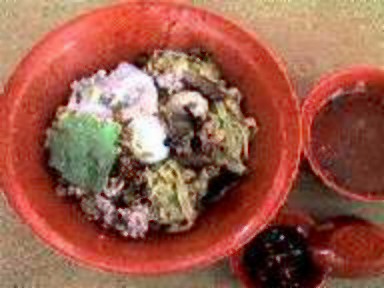
A popular variant of Gan Lao Mian - Bak Chor Mee, or Minced Pork Noodles
In Kuching, however, Kolo Mee is prepared very differently. The key is the condiment. Kolo Mee is usually prepared with a dash of pork lard and bits of fried garlic. The lard brings out the flavour of the garlic and enhances the taste.
Needless to say, Kolo Mee is both tastier and more unhealthy.
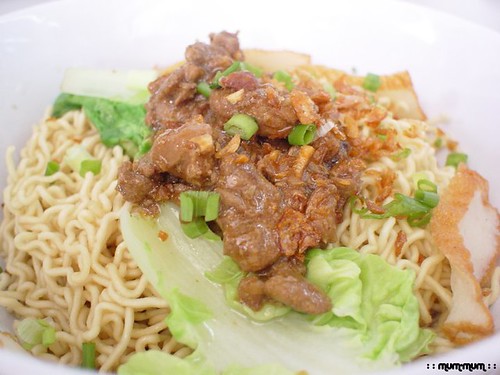
Health x Taste = Constant
Roti Prata and Roti Canai
Roti Prata is a popular Malay dish in Singapore. It's essentially a discus of dough that's been tossed around, then fried to give the dough some crispiness. It's eaten with curries.
This may come as a suprise to Singaporeans who do not frequent Malaysia, but according to my wife, the term "Roti Prata" does not exist in Malaysia. It's actually called Roti Canai, and the preparation method's slightly different.
In Malaysia, the dough is actually not fried to crispiness. It's fried to soft firmness, then given a few whacks on the sides to fluff it up, then possibly fried again for plebians who like crispy canai (which is apparently a distinctly Singaporean thing).
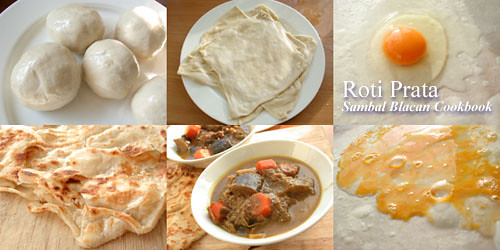
Laksa
The dish "Laksa" refers to a dish of rice noodles served in spicy gravy. Again the preparation method in Singapore and Kuching differ - most significantly on the gravy used.
In Singapore, actual curry is used. Because the curry is rich, pieces of tau pok (fried bean curd) are used to soak up the gravy. The noodles used tend to be thick, about the diameter of spaghetti. It's often served with fish cake and cockles.
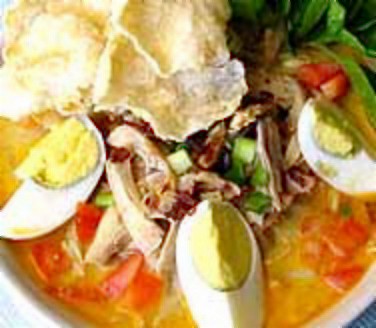
Singapore Laksa
Kuching Laksa is different. There's a special paste Kuching-ites use for their laksa. It's very much spicier and more fragrant than Singapore laksa. It's not often served with coconut milk either, so the gravy is less rich. The preferred type of noodles that are used tends to be vermicilli - which soaks up the gravy more efficiently.
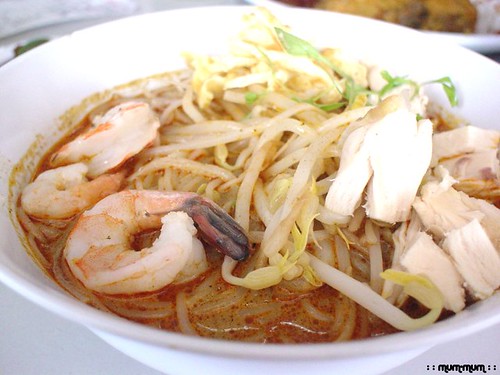
Kuching Laksa
That's all for the day. Hope I didn't make you too hungry. Heh.
P.S:

Technorati Tags: Singapore, Kuching, Food


8 comments:
That sounds good!!! Hey, do you debate at all? I just opened a debating blog and would be happy if you would debate. I have been going around and trying to get people to join. Its about which political party holds the most influence in the U.S.? Would be pleased if you come. If not, thats fine.
As a matter of fact, I used to debate competitively. I've since stopped for a number of years, but I'd be happy to check out your blog.
There used to be this stall near my old place at Joo Seng many years ago which served the Roti "Canai" version. Somehow I still perfer those kind of "Prata" than the completely cripsy one. Dunno if there are still such stalls around these days.
There's a decent non-crispy prata place at Owen Road. You'll have to travel quite far in though. It's in the housing estate area.
of course, there's the Sabah version - Kono Men... which is supposedly the Hakka form.
Fried noodles like your Kuching Kolo Mee stuff, but with added beaten egg, charsiew slices, chinese sausage slices, and egg-roll (meat with egg skin) slices... and a few token greens.
You must try that sometime, I think it's fab!
actually, there are many many versions of laksa in malaysia. i have found that johor laksa, which is very lemak (with coconut milk) is very close to the s'pore version. they also use the thick beehoon and shredded cucumber slices.
then there is the kelantan laksa. this is also lemak but not as chilli spicy as johor's or s'pore's. they use a fish paste in their kuah with lots of sugar, so it is a combination of salty-sweetness and coconut.
in the klang valley, their laksa is really curry mee --- with yellow noodles. this i don't really like --- it's not lemak at all; the kuah tastes like indian chicken curry.
i have heard that in sarawak laksa over 18 different ingredients go into the kuah. that is why it is such an intriguing mix of many flavours.
whatever the laksa origin though, it is always a pleasure to sample for die-hard s'porean foodies...just keep an open mind!
First time I've heard of those variants.
I'll be sure to try it next time I head there.
G'day, would like to point out that Kuching or Sarawak Laksa DOES contain coconut milk! Nothing beats it! It's virtually impossible to buy the paste outside of Sarawak, and I always have to get a stash when I visit Kuching! There used to be only one brand - Swallow, but there are a couple of copy cat brands now, all equally good!
Re: Roti Canai - Roti Tissue is a really interesting variation - a super soft and flaky and fluffy treat.
Post a Comment